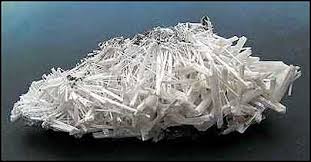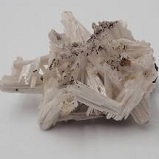Clear/misty white to brown. Helps us be centered, confident, capable and versatile amidst life's challenges. Grounding to here/now and higher self. Graciousness, good listening/communication skills. Translate higher concepts to everyday language. Psychicness, clarity. Shows what we can/can't change. Letting go (stress, addictions..) Insomnia, Central Nervous System, coordination, general healing. Both grounds root Chakra and opens crown (& Throat) CTR. Plant growth , protection against bugs.
Cerrusite, which used to be known as "lead spar" or "white lead ore", is a carbonate mineral that is an important industrial source of lead. It forms, colorless, white or gray crystals that vary from transparent to transluscent, and are often twinned in a characteristic manner. These are brittle, and have smooth faces with an adamantine, sub-metallic, or greasy luster. Cerussite also occurs in massive or fibrous forms, and is often associated with galena deposits as well as barite, calcite, and anglesite. Identification is relatively straightforward, as no other mineral has pseudo-hexagonal and twinned crystals with both conchoidal fracture and a high specific gravity. It has a white or colorless streak.
|
Chemical Composition: |
Lead Carbonate PhCO3 |
|
Color: |
Typically colorless or white — also gray green or yellow |
|
Hardness: |
3 - 3.75 |
|
Cleavage: |
Good in one direction |
|
Fracture: |
Conchoidal and brittle |
|
Crystal Formation: |
Transparent to transluscent; Orthorhombic |
|
Specific Gravity: |
6.5+ |
|
Occurence: |
Australia, Congo, Namibia, Germany, Morocco, and USA (Arizona) |
| Varieties |
 |
White Cerrusite |
White cerussite was used for many years as a primary pigment of white paint. Widespread recognition of its toxicity, however, resulted in it being withdrawn from the manufacturing process in relatively recent years. Despite it being a very delicate mineral that needs careful handling, specimens with well formed crystal structures are popular with mineral collectors — the best examples coming from the famous mines at Tsumeb, Namibia. Other sources include the Broken Hill mines in New South Wales, Australia, as well as Congo, Morocco, Germany and several other prominent sites in the United States. This mineral has an adamantine, sub-metallic, or greasy luster and a white streak.
| Chemical Composition: |
Lead Carbonate PhCO3 |
| Color: |
White |
| Hardness: |
3 - 3.5 |
| Cleavage: |
Good in one Direction |
| Fracture: |
Conchoidal and Brittle |
| Crystal Structure: |
Orthorhombic and Transparent |
| Specific Gravity: |
6.5+ |
| Occurence: |
Namibia, Congo, Morocco, Australia, Germany and USA |
|

